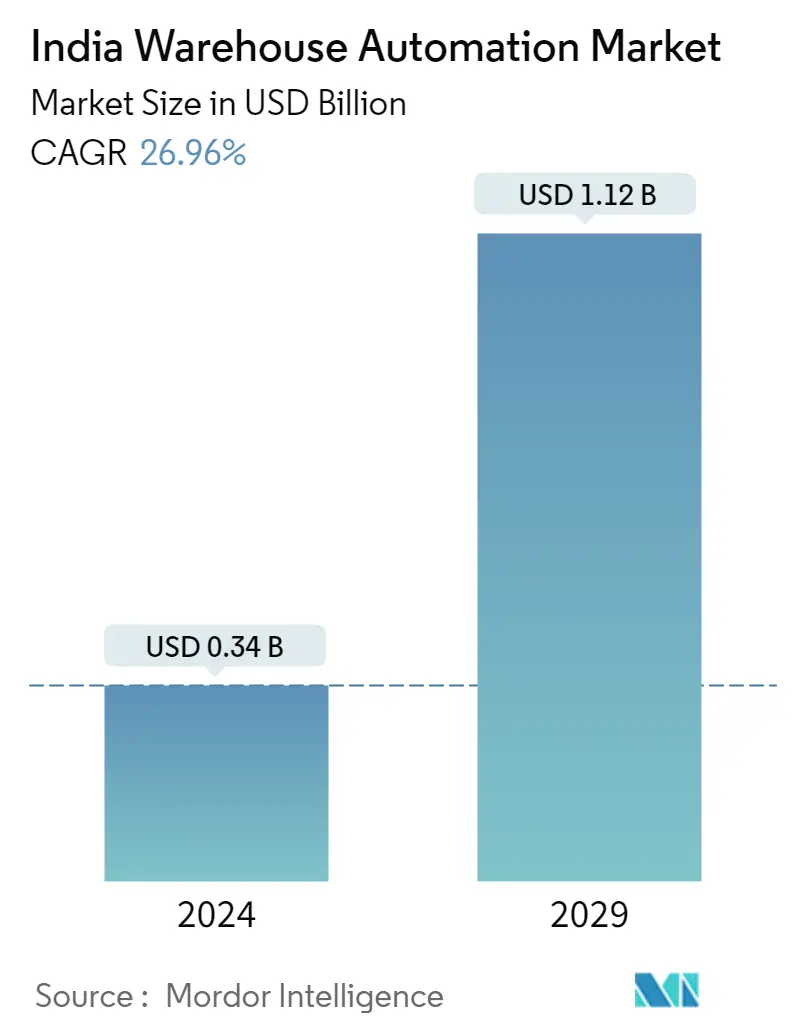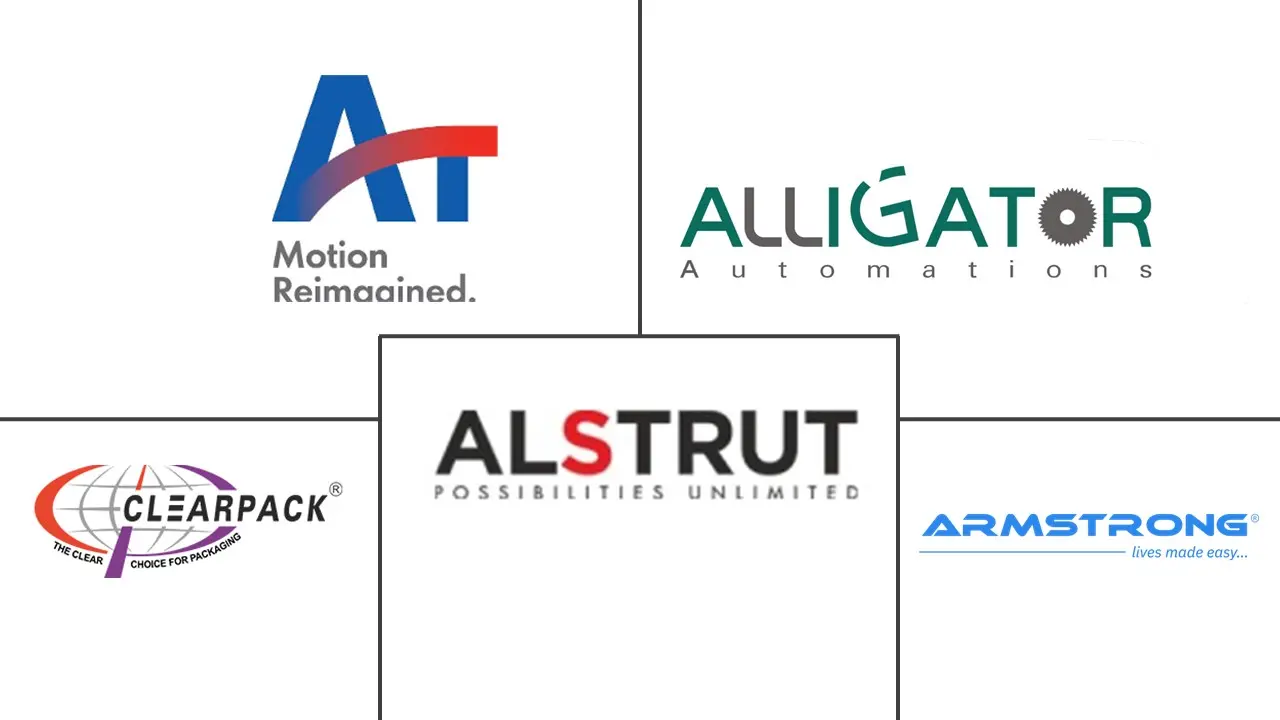Market Size of India Warehouse Automation Industry

| Study Period | 2019 - 2029 |
| Base Year For Estimation | 2023 |
| Market Size (2024) | USD 0.34 Billion |
| Market Size (2029) | USD 1.12 Billion |
| CAGR (2024 - 2029) | 26.96 % |
| Market Concentration | Low |
Major Players
*Disclaimer: Major Players sorted in no particular order |
India Warehouse Automation Market Analysis
The India Warehouse Automation Market size is estimated at USD 0.34 billion in 2024, and is expected to reach USD 1.12 billion by 2029, growing at a CAGR of 26.96% during the forecast period (2024-2029).
For estimating the market studied, types of solutions covered under the scope have been analyzed individually, including conveyor and sortation systems, palletizers, mobile robots (AGV/AMR), vision inspection equipment, and labeling equipment employed in the FMCG industry.
- Warehouse automation is the process of employing technology to increase the efficiency of warehouse processes, like moving and assembly. These processes involve mechanics to help move products between facilities or database systems to help track each area or warehouse. Warehouse automation has become essential, especially for FMCG players dealing with bulk goods and items. Several areas require adequate focus and advancements, from inbound to storage to outbound transit, to make the process seamless.
- A significant component of warehousing and fulfillment operations is proper inventory management. It enables the company to re-order and stock products effectively to avoid excess inventory and stock-outs. Warehouses handle inventory using warehouse management software that provides real-time inventory management capabilities.
- Material handling in warehouses has undergone various transformations that have changed the industry's outlook. Material-handling machines and mobile robots have replaced individual workers. Due to this transformation, many industries have grown, including FMCG. The rising infrastructure investment from the government, industries and the 'Make in India' initiative are expected to drive the demand for warehouse automation systems.
- Developing economies such as India have been representative of labor-intensive formats. With labor costs significantly low compared to other developed countries, high investment in specific warehouse automation systems with additional staff training has restrained the adoption of warehouse automation, especially in SMEs.
- In January 2022, due to the spike in COVID-19 cases across the nation, customers stocked up the goods, increasing demand for FMCG businesses, which increased supplies to their stockists to avoid a supply crisis. Companies like Parle Products, Dabur India, and ITC, which are already dealing with inflationary pressures on inputs, are keeping extra stock of raw materials to prevent any supply chain disruptions brought on by the new wave of the COVID-19 pandemic. They do this by applying what they learned from the previous two waves.
India Warehouse Automation Industry Segmentation
Warehouse automation is the process of automating the movement of inventory into, within, and out of warehouses to customers with minimal human assistance. Warehouse automation refers to devices or systems that streamline repetitive warehouse operations and make them less labor-intensive to generate greater operational efficiencies. Warehouse automation is an integral entity of supply chain optimization, as it reduces time, effort, and errors caused due to manual or repetitive tasks.
The market size for the Indian warehouse automation market (henceforth referred to as the market studied) was evaluated by analyzing the independent type of solutions, such as conveyor and sortation systems, palletizers, mobile robots (AGV/AMR), vision inspection equipment, and labeling equipment that are employed in the FMCG industry. The study tracks the key market parameters, underlying growth influencers, and major vendors operating in the market study, which supports the market estimations and growth rates over the forecast period. The report also covers the major factors impacting the market growth regarding drivers and restraints. The study analyzes the overall impact of the COVID-19 pandemic and addresses the market dynamics. The market sizes and forecasts are provided in terms of value (USD million) for all the above segments.
| By Type | |
| Palletizers | |
| Conveyors and Sorting Systems | |
| Mobile Robots (AGV/AMR) | |
| Vision Inspection Equipment | |
| Labelling Equipment |
India Warehouse Automation Market Size Summary
The warehouse automation market in India is experiencing significant growth, driven by the increasing demand for efficiency in logistics and supply chain operations. This growth is particularly evident in the fast-moving consumer goods (FMCG) sector, where automation technologies such as conveyor systems, mobile robots, and labeling equipment are being integrated to streamline processes from inbound logistics to outbound transit. The rise of e-commerce has further accelerated this trend, as companies like Amazon and Flipkart invest in automated solutions to meet the growing consumer expectations for faster and more accurate deliveries. The government's initiatives, such as 'Make in India,' along with substantial infrastructure investments, are also contributing to the market's expansion, encouraging the adoption of advanced automation systems.
Despite the promising growth prospects, the adoption of warehouse automation in India faces challenges, particularly in small and medium enterprises (SMEs) due to the historically labor-intensive nature of the economy and lower labor costs. However, the shift towards automated solutions is becoming more pronounced as companies recognize the need to optimize inventory management and reduce reliance on manual labor. The market is characterized by competitive dynamics, with key players like Falcon Autotech and Addverb Technologies leading the charge in innovation and strategic partnerships. These companies are enhancing their offerings with advanced technologies, such as modular sortation systems and robotic solutions, to cater to the evolving needs of the Indian market. As the FMCG sector continues to expand, driven by increased consumption of packaged foods and non-alcoholic beverages, the demand for warehouse automation is expected to rise, further shaping the industry's landscape.
India Warehouse Automation Market Size - Table of Contents
-
1. MARKET INSIGHTS
-
1.1 Market Overview
-
1.2 Industry Attractiveness - Porter's Five Forces Analysis
-
1.2.1 Bargaining Power of Suppliers
-
1.2.2 Bargaining Power of Buyers
-
1.2.3 Threat of New Entrants
-
1.2.4 Threat of Substitutes
-
1.2.5 Degree of Competition
-
-
1.3 Assessment of the Impact of COVID-19 on the Industry
-
-
2. FMCG MARKET OVERVIEW
-
3. MARKET SEGMENTATION
-
3.1 By Type
-
3.1.1 Palletizers
-
3.1.2 Conveyors and Sorting Systems
-
3.1.3 Mobile Robots (AGV/AMR)
-
3.1.4 Vision Inspection Equipment
-
3.1.5 Labelling Equipment
-
-
India Warehouse Automation Market Size FAQs
How big is the India Warehouse Automation Market?
The India Warehouse Automation Market size is expected to reach USD 0.34 billion in 2024 and grow at a CAGR of 26.96% to reach USD 1.12 billion by 2029.
What is the current India Warehouse Automation Market size?
In 2024, the India Warehouse Automation Market size is expected to reach USD 0.34 billion.

